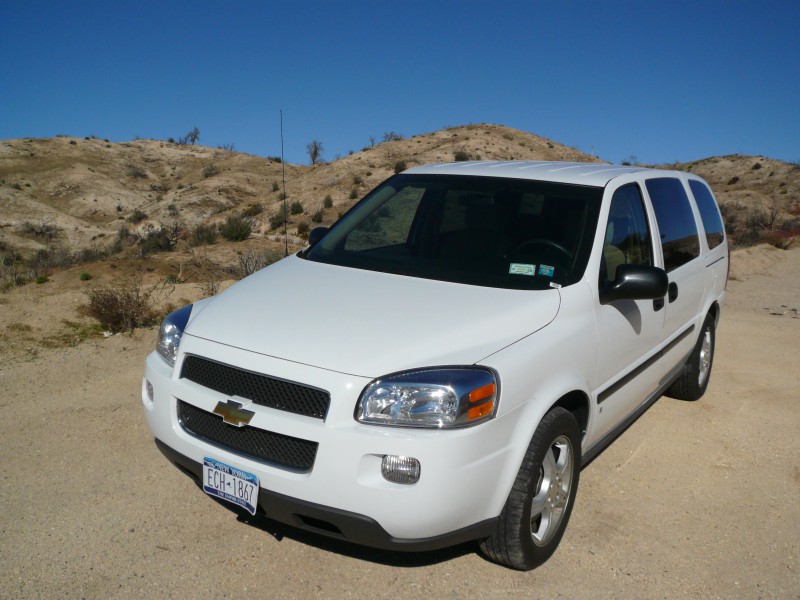

The success of the first “MiniVan”, the Plymouth Voyager, launched in 1984, took everyone by surprise. It was not long before all the major manufacturers competing in the US market had launched their own rivals, all of which followed a similar format. Twenty years later and things look quite different, with a vast increase in popularity of first the SUV, and then, in an attempt to eradicate some of the “challenges” of these vehicles, the Crossover. MiniVan sales reduced dramatically, and Ford exited the market about 3 years ago when the Freestar faded away. At the time, GM made no bones about the fact that when their recently refreshed range of MiniVans – Chevrolet Uplander, Pontiac Montana, Saturn Relay and Buick Terrazza – reached the end of their planned production life, they would not be directly replaced. As these vehicles, launched in 2004 were not truly new, rather a comprehensive workover of the cars launched in 1997, which also sired the unloved Vauxhall/Opel Sintra in Europe, it was likely that their life would not be long. Surprisingly, the Chevrolet Uplander lived on throughout the 2008 model year, and only recently has ceased production. GM’s replacements are the much praised “Lambda” based vehicles, the Buick Enclave, Saturn Outlook and GMC Acadia, and new for 2009, the Chevrolet Traverse. Whilst these Crossovers had all the column inches in the past 18 months or so, the question is whether the outgoing Uplander is actually any good, or not.

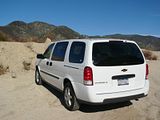

For the final 18 months production, the Uplander was fitted with the familiar 3.9 litre V6 engine that sees service in many of GM’s mid-sized vehicles. Not exactly bristling with modern technology, it is nonetheless reasonably refined, and generates 240 bhp, which is the sort of power needed to propel such a large vehicle as the Uplander. And make no mistake, this thing is large. Indeed, since the test vehicle was the long wheelbase version, it is positively huge, with ample space for 7 adults and a certain amount of luggage. First impressions were OK, as I fired up the engine, and listened to it with the window open, manoeuvering towards the rental area exit point at Hertz’ Los Angeles base. It actually sounded agreeable, with that satisfyingly even balance of a V6 engine. With window closed, the sound largely disappeared, and the engine simply got on with its job. In this respect, the score has to be “adequate”. I did not test the Uplander laden with more than just me and my suitcase, and it was well able to keep up with the flow of traffic on the Los Angeles freeways (yes, they do move at speed some times!), and on the hills of the San Gabriel mountains, the engine was not found particularly wanting, either. It’s not a fun engine to work hard, for sure, but it can be revved to get the extra momentum, if the need arises.There is a four speed automatic gearbox, which shifts smoothly between the gears. My initial impression was that the Uplander was fairly economical, as the fuel gauge barely moved for quite a while. Then I discovered that the tank holds 25 gallons, so you have to use quite a bit of fuel before a big enough percentage has been consumed, and can be reflected on the dial. In fact, I got about 22mpg, which is not brilliant, but would seem to be about average for these sort of vehicles. You do not really expect a MiniVan to be the last word in steering precision, handling and generally being fun to drive. With that expectation set, then perhaps the Uplander will not disappoint unduly. The steering is light enough, and precise enough, but the Uplander does understeer quite noticeably, and it leans rather a lot on corners. I took it on the usual test route for Southern California, up in the San Gabriel mountains, and it held the road reasonably well on the swooping bends of the Angeles Crest Highway, but I am sure I would have pushed a saloon car quite a bit harder without feeling that I was risking anything. The brakes were fine, untroubled by the descents. Uplander rides well, too. Not surprisingly, given the long wheelbase, and the typical soft suspension, and it is not noisy at freeway speed.
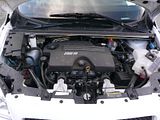
People who buy the Uplander are going to be far more interested in practicality and space than the ultimate driving dynamics. Here the Uplander does quite well. This is a big vehicle. It is long, because of the extended wheelbase, which provides for 7 seats and luggage room, and it is also tall. It is not as big as an equivalent sized SUV, though, and getting into it does not require the noticeable climb upwards that is needed to access a Trailblazer or an Explorer. Just a slightly higher “climb” than a regular saloon car. There are two benefits from the height, of course. One is that there is masses of headroom, and the second is that the natural driving position is that bit higher, so you do feel that you have a good view over surrounding traffic. There are two completely separate chairs up front, each of which has a swivelling armrest. Leaving the armrest down made it slightly awkward to buckle the seat belt, but I quickly adopted the technique of getting the belt fastened. There is a sizeable gap between the front seats. There is a net on the lower side of the driver’s seat, and a hook on it so it could be stretched over this gap, to provide a stowage area for smaller items. The middle row of seats also number two separate “captain’s chairs”. These are on a slider, so can be slid back and forth to optimise the relative amounts of leg room needed for each line of passengers. Even with the middle row of seats set as far back as they would go, there is ample space for the passengers in the rear most row of seats. Although there are only 2 headrests provided, there is ample space for 3 adults to sit in here. Access from the rear-sliding doors on each side of the vehicle, and by tilting the middle row of seats is easy, and you can almost stand up in the Uplander. Behind all this lot there is some boot space. It is deep, but not very long from back to front. Various permutations of folding and tilting both rows of seats are possible.The rearmost row allegedly can be removed completely, though I failed to do this – my reading of the instructions in the handbook was clearly a little too cursory. The middle row of seats can be folded over and tipped forward in Uplander versions where there are no side air bags (which I believe included the test car, though again, I did not manage to tip the seats forward). In any case, you could easily fold down the seats to get access to a cavernous vehicle interior. There are plenty of other clever tricks to make the most of the available space. At the bottom of the centre console is a huge cubby which goes back further than I could reach, as well as a sizeable glovebox, and big door bins. On the back of the front seats there are drop down cubbys which could be used for additional items for the middle row of passengers. Sprouting out of the top of the backrests of these seats was an odd-looking plastic clip, on a long piece of retractable elastic, which looked like you could attach something to it, perhaps a book or something to entertain the people sitting there.
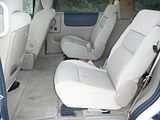
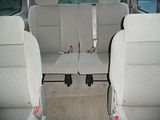

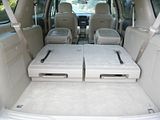
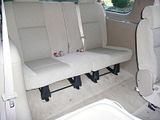
The interior was one of the areas of the car to get a major makeover when Venture became Uplander. To some extent, it was successful. The dash is a vast improvement on the sort of horrid cheap and nasty item that used to be found pervasively in American products until recently. A simple cowl covers the clearly marked main instruments of speedo, rev counter, minor gauges and transmission selector indicator. Although the plastics are not the softest around, they are actually of acceptable quality, and they fit well. The quality of the other switches is decent enough, though the awkward GM standard single column stalk with a “keep twisting” technique for operating the wipers is an unwelcome reminder of the Bad Old Days. The whole effect is brought into question by the use of some rather nasty fake wood on the centre console and on the doors, but it’s a relatively small area of the whole dashboard. The gearlever is an old-style column shift, on the right of the column. The only way to tell which gear is selected is to look at the selector in the instrument binnacle, but it shifts easily from gear to gear. There is a traditional foot operating parking brake, which you push to set and push a bit harder to release.
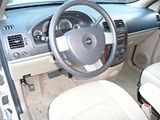
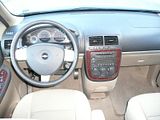
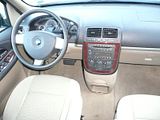
One of the major objectives of the 2004 facelift was to improve the safety standards. Like most MiniVans, the Venture/Montana duo, and their European equivalents had not done well in crash testing. The new nose was intended to improve frontal impact performance. Luckily, I had no chance to assess this. I did note, however, that there only appeared to be an airbag in the steering wheel, and one above the glove box for the front passenger. A far cry from the 9 or so bags that appear in most more recently designed vehicles.

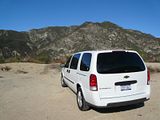
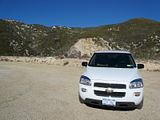
The test ended sooner than I expected, as driving at the height of the Los Angeles rush-hour, in the middle of a 6 lane freeway, a warning light for “check tyre pressure” illuminated. As soon as I could safely stop and have a look, the tyre appeared OK, but not sure what was causing the warning, I took the Uplander back to Hertz, and swapped it out. Hertz had little other than MiniVans to offer, so I will have the ideal opportunity to compare this vehicle – rated by the US’ Consumers Guide the lowest among MiniVans – with the one they rate the best. But that’s for another test! My expectations were not high for the Uplander, as I had read that it is dated, and not competitive. Apart from the lack of the most modern safety features, I don’t think it is as bad as that. But, I will review my verdict when I have driven the competition. Watch this space.
2009-11-23 07:27:59

















